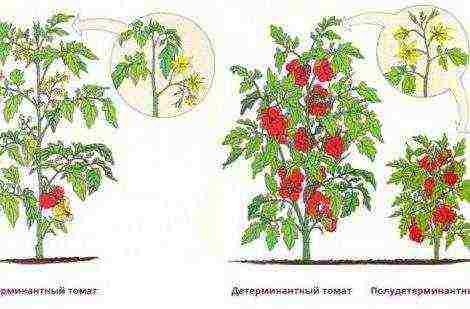Content
- 1 What flowers are called dried flowers: 20 of the most popular types
- 2 Rules for cutting and drying dried plants
- 3 Using dried flowers to decorate your home
- 4 1. Gypsophila and other lace dried flowers
- 5 Annual dried flowers
- 6 Perennial dried flowers
- 7 Bulbous dried flowers
- 8 Use of ornamental cereals as dried flowers
- 9 Landscape decoration with tall dried flowers
- 10 Immortelle, gomfrena, rudbeckia
- 11 Immortelle flowers or immortelles
- 12 Celosia
- 13 Craspedia
- 14 Feverweed
- 15 Plants with interesting fruits
The season of summer colors and floral aromas in most regions of Russia does not last long, and on gloomy and rainy autumn days and in the gray frosty winter months, one wants to return to the summer fragrant garden.
Compositions of dried flowers will help to keep the summer mood, which will fill the house with warmth, colors and a delicate aroma. At the same time, growing dried flowers and making compositions from them with your own hands is quite simple and very exciting.
What flowers are called dried flowers: 20 of the most popular types
Theoretically, any flowering plant after drying can be considered a dried flower, but from the floristic point of view, not every plant is able to maintain its integrity and aesthetics after cutting and drying. Most of the "stars" of the flower garden, as they dry out, lose the brightness of colors and flower shape, become fragile and quickly shed their leaves and petals. Therefore, only some special types are used for artistic crafts. In this case, not only buds and blossoming flowers are used, but also seed pods or fruits.
Dried flowers are relatively durable compared to other garden and wild flowers and herbs, but without special treatments, home bouquets and handicrafts can keep fresh for no more than a year. For summer residents, this option is very convenient: choose the species and varieties you like in the spring, make a cut, prepare the material, decorate the house for the winter, and with the beginning of the new season, bring fresh ideas to life.
Most dried flowers are characterized by unpretentiousness to growing conditions and resistance to adverse weather factors. Allocating some space in the garden for these plants, you should not prepare for additional hassle. Most of the species are distinguished by high drought tolerance and photophilia.
In order not to get confused in the variety of varieties, beginners in this field can choose only a few species to begin with. The following photos and names of dried flowers with a brief description will help in this.
Winged ammobium... Perfect for growing in Central Russia. Forms numerous small baskets. In floristry, blossoming inflorescences with a high shoot are used.
Helipterum... It has several types and varieties that differ in the type, size and color of the inflorescences. Harvested during the period of full disclosure of flowers.
Gelichrizum (immortelle, tsmin, "cat's paws"). It can have simple and double inflorescences of white or red color, varieties with multi-colored inflorescences have been bred. At a distance, the fluffy inflorescences are very reminiscent of the soft paws of cats, which became the basis for the popular name. Material harvesting begins in the half-run.
Statice (kermek)... Forms corymbose inflorescences, consisting of small brightly colored flowers. The most attractive are bouquets cut at the height of flowering.
Xerantemum (dried flower)... On thin, highly branched stems, small simple baskets of white, purple, pink or red color are formed. Cut off during the period of complete dissolution of the inflorescences.
Amaranth... Differs in large racemose inflorescences on a strong stem. For a winter bouquet, brushes are used in the beginning of flowering phase.
Cartamus (safflower dye). Forms large flowers of yellow, orange and red color, which are cut in full flowering phase.
Gomfrena... A very popular dried flower with white, lilac, red and pink globular inflorescences and decorative leaves.
Craspedia... An interesting species with dense, yellow, globular inflorescences on a slender shoot without leaves. For compositions, small bunches of several inflorescences are often used.
Celosia pinnate... It differs in large inflorescences - panicles, which, depending on the species, can be yellow, orange, red, purple and even pale cream.
Mordovnik... Refers to "thorns", has large, blue, spherical inflorescences.
Feverweed... Another bright representative of the "thorns". Differs in capitate inflorescences of steel color with openwork leaf wrapper.
Physalis ("flashlights")... This plant is grown not for the nondescript white flowers, but for fruit, surrounded by enlarged sepals of a bright carrot color. From the outside, these lanterns look like paper.
Briza (shaker)... A popular dried flower herb with spectacular numerous spike-shaped milky inflorescences.
Lagurus (haretail)... Another representative of ornamental grasses with lush inflorescences resembling a hare's tail.
Lunaria (lunar)... One of the few dried flowers that can decorate both the summer garden with its flowering and the house with its fruits. For arrangements, not exactly fruits are used, but the remaining elements after the destruction of the pods. Moon-shaped translucent partitions look very cute.
Aflatunsky onion. One of the representatives of decorative bows, which is gaining popularity lately.
Nigella... Forms delicate single flowers of different colors. For floristry, decorative seed pods are of value.
Tansy... Even after drying, this medicinal plant produces phytoncides that purify the air. In central Russia, it is often found in the wild.
Echinacea Another medicinal plant that will complement the winter bouquet. It is not the inflorescences that are cut off, but the seed head after the petals fall. Gaillardia can also be used instead of Echinacea. Such fluffy balls on a straight leafless shoot will add more originality to the composition.
The list of plants from the group of "dried flowers" is not limited to our 20th. All decorative cereals (millet, maned barley, miscanthus, polypogon, spreading fire, etc.) are excellent for winter arrangements. For fragrant bouquets use inflorescences of herbs (hyssop, lofant, lemon balm). Lavender is often present in the compositions. It is not at all necessary to plant the necessary plants in your garden - the suitable material can also be found among the wildflowers.
Rules for cutting and drying dried plants
There is no single cutting period for dried flowers. When to cut the inflorescences depends on the specific species. Florists are guided by their many years of experience. The only common thing is that by the time of cutting, the plant must enter the required growth phase: if we need flowers, then this phase will be the complete dissolution of the flower bud, and if the seed pods and fruits, then the ripening of the seeds at the end of the growing season. Drying and wilting of plants on the root should not be allowed. It is also necessary to cut off green shoots, full of vital energy.
Cutting must be carried out in dry weather. Before this, a place for drying and the necessary tools are prepared in advance. The room must be dry, ventilated and dark. The brightest and largest specimens without defects and a sign of disease are chosen as material for future crafts. The inflorescences are cut along with a long shoot. The longer the shoot or peduncle, the more convenient it is to dry, and the excess can always be trimmed.
To get quality material for work, you need to know how to properly dry dried flowers. Small bunches are made from cut shoots, which are tied and suspended with inflorescences down. For some species, upward drying is required (for example, for craspedia).
Without access to sunlight, dried flowers retain their bright natural color. To discolor the plants (if further staining is planned), they are sprayed every two days with water from a spray bottle with a fine spray.
The material for paintings and panels is dried by straightening, giving them the desired shape and securing them with threads on the board. In the future, inflorescences and fruits are stored in cardboard boxes until use.
Air drying is the easiest and most affordable way, but there are alternatives. Drying with moisture-absorbing silica gel is used for large flowers (peonies and roses). To do this, the flowers are covered with a mixture of silica gel with sand and left for 3 - 5 days, checking the condition of the inflorescences daily to prevent overdrying. For the manufacture of paintings and panels, you can use the material obtained by herbarium drying familiar from childhood. More experienced amateur florists also use glycerin drying.
In floristry shops, you can buy dyes and varnishes to extend the life of the future composition.
Using dried flowers to decorate your home
Floristry allocates an important role for dried flowers, while amateur flower growers do not always imagine how dried flowers can be used in the interior.
The whole variety of floral arrangements can be divided into the following blocks:
- winter bouquet;
- painting;
- decorative panel;
- author's crafts;
- compositions in the form of baskets and wreaths.
Next, we will present a description and a master class of design examples from each block and note the features.
When looking for ways to decorate the house with dried flowers, the very first thing that comes to mind is a living bouquet in a decorative vase. This idea seems to be the simplest and easiest to implement. However, to make a bouquet of dried flowers with your own hands, you need to know some tricks. It is advisable to select a vase depending on the prevailing tones in the bouquet.
For example, light yellow “straw” bouquets go well with wood, glass and clay, and for multi-color compositions you can choose a bright ceramic vase.
When drawing up a bouquet, shoots with inflorescences are disassembled into bunches and tied with a floral ribbon. Then the individual elements are collected in a common bouquet and also tied.
The material for paintings in the form of flat appliqués is dried by pressing. A herbarium can be made from your favorite garden flowers or you can collect field plants. As decorative elements, you can use not only inflorescences, but also leaves, seeds, curved shoots. Any composition is laid out on thick plain paper, everything is fixed with glue and the finished work is placed under the glass of the photo frame.
It is considered more difficult to make volumetric paintings in which cut inflorescences with a preserved shape are used.
A bright panel of dried flowers will certainly fit into the interior of the kitchen. To make such a panel, as shown in the photo, you will first need to make a base in the form of a ring from willow rods, and then fix the blanks: spiraea, rye, tansy, cmin, rose, aster, chrysanthemum. The list of dried flowers can be completely replaced.
Author's crafts can be very different depending on the breadth of imagination. The most popular is topiary - a small tree that brings happiness.
Any wicker basket is suitable for composing compositions with dried flowers. As a basis for attaching flowers, a floral sponge is used, which is filled with a basket. From above, the sponge is masked with moss and proceeds to fasten the dried flowers. In the future, it will only be possible to replace the flowers with fresher ones.
Wreaths of dried flowers look completely different in the interior. Taking up very little space on the wall or on the door, they are able to fill the room with a special aura.To make the hoop, you can use dry twigs, flexible willow shoots, metal rods or wire. Non-natural material is masked with woolen or cotton thread.
It will not be difficult to grow dried flowers in your summer cottage. Most species grow well not only in the Moscow region, but also in the Far East. Moreover, high summer temperatures can negatively affect the growth of shoots and the formation of inflorescences. But if it is not possible to grow your own flowers, quality material for creative crafts can always be purchased at floristry stores.
Related videos:
Source
The blooming garden is so beautiful that they want to admire it endlessly. From early spring to late autumn, there are sure to be big and small, modest and most unassuming stars in it. And as soon as the garden kingdom is shackled by the first cold weather, we all begin to dream of a new beginning.
Even in the coldest season, they help to admire the beauty of garden flowers. dried flowers - a group of crops that perfectly retain the shape and color of inflorescences in winter bouquets. Even after long drying, they look fresh and alive, a small piece of summer in the interior.
A variety of dried flowers can satisfy even the most capricious florist today. Large and small-colored, colorful and pastel, touching or flashy flowers and inflorescences allow you to experiment with winter bouquets or revitalize the decor of rooms, bring the beauty and variety of garden life into autumn or winter interiors.
Let's take a closer look at the best dried flowers.
See the list of dried flowers for winter bouquets on the next page.
1. Gypsophila and other lace dried flowers
Gypsophila, also known here as kachim, is not only one of the most popular veiled garden plants, but also a wonderful dried flower. The snow-white lace of her inflorescences looks great in winter bouquets, giving them airiness, elegance and weightlessness. Gypsophila is mainly used as a background culture in floristry: it sets off the bright inflorescences of other plants, in particular, basket-type dried flowers.
In addition to ordinary gypsophila paniculata, original varieties are also used for cutting - terry form, pink "Flamingo", dark pink gypsophila "Pink Star", etc.
Growing conditions: for cutting, you need to plant gypsophila in sunny areas in nutritious, drained and calcareous loams and sandy loams.
Required care: watering during very long droughts is needed only for young plants, while adults do not water or feed; with aggressive growth, they are limited by pruning.
Cutting time: gypsophila blooms in July-August for almost a month and a half, inflorescences with fully open flowers are cut off from it; cutting into bouquets can be carried out only from the third year of cultivation.
Drying features: without hanging, in vases or jars without water, where the gypsophila is placed until completely dry, in dry and light rooms.
Plants that look like gypsophila
Kermek - annuals and perennials with very dense scutes, panicles or spheres of inflorescences consisting of numerous spikelets. It seems thicker and brighter than gypsophila, and its color palette is wider - from white to pink, salmon, yellow, blue and lilac tones in the brightest variations.
Kermek also loves sun and well-drained soil, but requires frequent feeding. The inflorescences are cut after the flowers have fully opened up to the very frost, but they are dried only in shade, in well-ventilated rooms, hanging the bundles with the stems up. Pink and salmon flowers fade in the sun, but yellow and blue (like white) perfectly retain their color even after years.
Yarrow ptarmica - the most popular type of garden yarrow for dry bouquets. It seems to be an enlarged copy of gypsophila: shining flowers seem to be a scattering of pearls on dense inflorescences.The sizes of individual flowers are larger than those of gypsophila (sometimes more than 1 cm), almost all modern varieties are double. It is also cut off after full blooming.
Yarrow ptarmica, or sneeze herb, common sneezer
See the continuation of the list of dried flowers for winter bouquets on the next page.
Often, when creating dry bouquets, various dried flowers are used. Moreover, they are also used in landscape design. What kind of dried flowers are suitable for both bouquets and landscape compositions? Let's consider the name of each popular flower and its description in more detail.
Dried flowers are divided into several subcategories, namely:
- annuals;
- perennial;
- bulbous;
- decorative cereals as dried flowers.
Annual dried flowers
It has always been believed that the definition of dried flowers means exactly annuals. Even other definitions can be attributed to this category: “true dried flowers” or “immortelles”.
If we talk about the plants themselves, then from this category for the formation of bouquets and in landscape design they use:
- Gelikhrizum;
- Helipterum;
- Rodante;
- Xerantemum;
- Kermek.
Gelichrizum
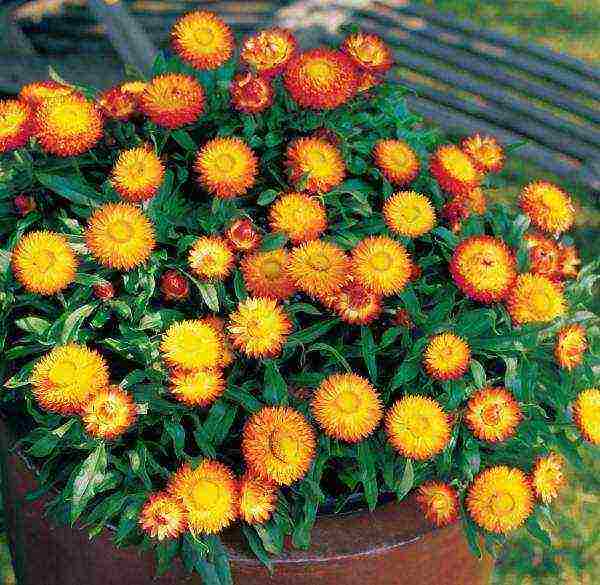
Gelichrizum
This plant confidently holds the lead in popularity from this subgroup. This is quite natural, since Gelichrizum has the largest variety of color palette. Today, every landowner can purchase this plant with this color:
- Red;
- White;
- yellow;
- Orange;
- pink;
- and even crimson.
The height of Gelkhrizum can vary from 25 to 80 centimeters.
Helipterum
Abundant flowering of Helipterum roseum
This type of dried flowers is not much different from the previous Gelikhrizum. But at the same time, a small difference lies in the fact that the middle is clearly drawn in them: yellow or dark.
By itself, Helipterum includes one advantage: it fits perfectly into any bouquet.
If we talk about using it in landscape design, then it is not uncommon to find it in rockeries, rock gardens. The height of its bush does not exceed 45 centimeters.
Xerantemum

Xeranthemum
This variety of annual dried flowers is completely identical to the above varieties, both in shape and in color.
However, there is still a slight difference: their terry inflorescences are tougher than others, and the petals themselves are longer.
Care and cultivation
Annual dried flowers require the same care, regardless of their variety.
In the process of growing them, they must be fed with mullein or rabbit dung. This is primarily necessary in order to get excellent inflorescences when creating landscaping or in bouquets.
If we talk about the cultivation itself, then the seeds of annuals are sown directly into the open ground. However, there is a small caveat. It concerns low-growing dried flowers - it would be better to grow them by seedling method.
To do this, you must initially plant them either in a wooden box or in pots, and after they grow up to about 15 centimeters, transplant them into open ground.
When sprouting or transplanting into the ground, it is necessary to regularly spud them around the trunk. In the event that the ground is solid, it can harm them, and they will simply dry out or wither.
In landscape design, you can see how they look:

Any dried flowers look great in rockeries

Dried flowers are also able to successfully complement any brighter annuals or perennials.
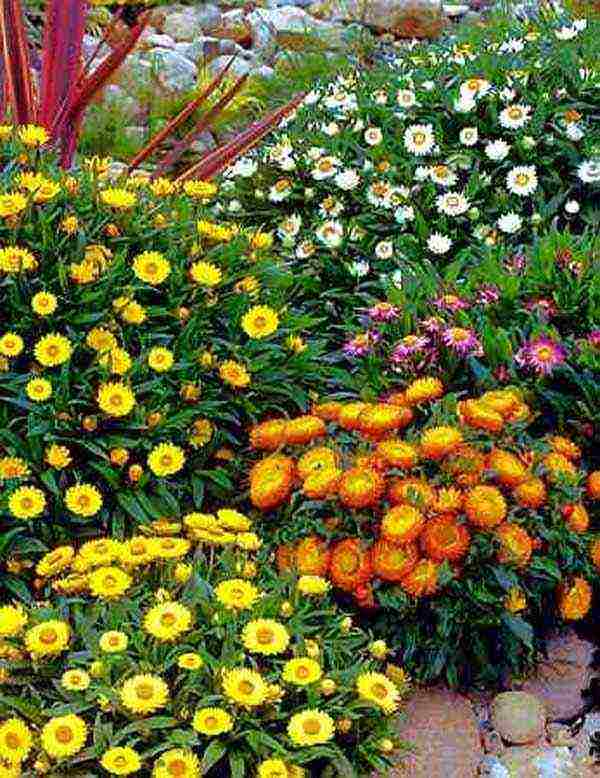
Curtains of helihrizums as the only bright accent
Perennial dried flowers
Varieties of plants from this subgroup are very easy to dry, and also fit perfectly into any composition.
The most popular and rare perennial dried flowers are considered to be:
- Anafalis;
- Gypsophila;
- Millennium;
- Pearl oyster;
- Lavender;
- Astilba.
Anafalis

Anaphalis
The bluish-white inflorescences of this variety of flowers can completely complement any composition.In the event that landowners are going to use it in landscape design, it is recommended to buy already grown plants, since it is very difficult to grow from seeds on your own.
It is recommended to cut the inflorescences, if necessary, drying immediately after they bloom. If this is done late, it will be problematic to dry, since the leaves may crumble.
Gypsophila
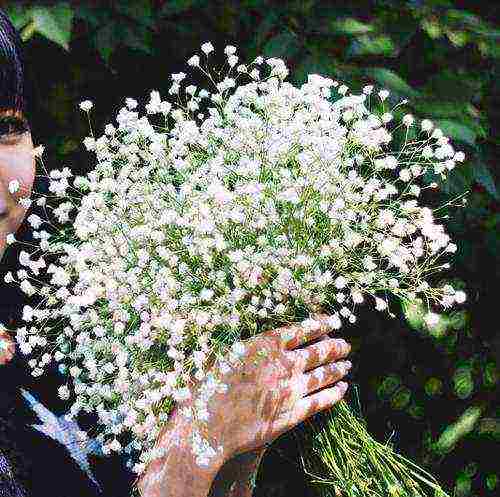
Hyposphilus in a bouquet
The perennial plant has small and non-double flowers. At the same time, the very type of inflorescence from this variety of plants has a delicate appearance, which is able to create the illusion of a kind of white cloud.
When growing it on your land plot, it must be borne in mind that it should be grown from seeds and immediately planted in open ground. This is due to the fact that she is not very fond of her transplant.
If it is necessary to dry it, this is done very simply. To do this, it is enough to cut the branches, where the flowers have already completely blossomed, and then put them in a vase, and wait until they are completely dry.
Yarrow

Yarrow
Today in nature there are many varieties of yarrow with different color shades: white, yellow, red, and so on.
This plant is unpretentious, and does not require any special care.
As for cultivation, its seeds are immediately planted in open ground from September to mid-November. Having planted in the fall - next summer it will delight the eye with its beautiful inflorescences.
"Pearl"
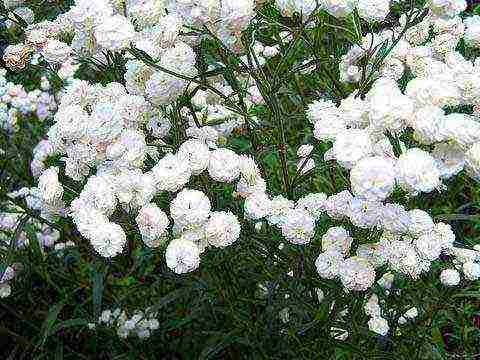
Yarrow ptarmica "The Pearl", pearl mussel.
This plant also has a popular name - sneeze herb. Another name is Ptarmika. It is a species of yarrow. It should be noted that in appearance the Pearl does not look like a yarrow. Agree, large terry inflorescences are more like gypsophila.
But if we talk about the very care and planting, then this process is very easy. Having landed it in the open field, it is necessary to monitor its processes every week, since it grows at an incredible speed.
To create bouquets from this plant, it is necessary to collect only those branches on which the flowers have completely blossomed. In the event that this is done 2-3 days after the dissolution, they will darken.
Lavender

Lavender (Lavandula)
This variety of dried flowers is used in landscape design, and in the bouquets themselves, not only because of their beautiful appearance, but rather, on the contrary, because of the incredible aroma.
If you use it in dry bouquets, after cutting the branches, place them in a dark place, hanging them on the opposite side from the flowers. If you dry them in the light, the color shade will quickly lose its natural beauty and fade.
Astilba

Astilba
A wonderful perennial plant that includes dense inflorescences in the idea of a panicle, which can be of such color shades as: pink, lilac, white or red.
For dry bouquets, this plant should also be dried in a dark room so as not to lose its natural beauty.
It should be noted that it would be better to use them in combination with several varieties of other colors, otherwise, in a single version, the composition will be very boring. Although the photo on the left refutes this.
Care and landing
Perennials do not require any special care. It is enough to ensure that the land does not dry out, and in the summer, provide abundant watering.
Growing is quite simple: you can buy ready-made cuttings or grow from seeds.
Seeds are usually sown in winter, and in spring next year they will be able to delight the eyes of their owners.
From perennial dried flowers, you can achieve the following compositions in landscape design:
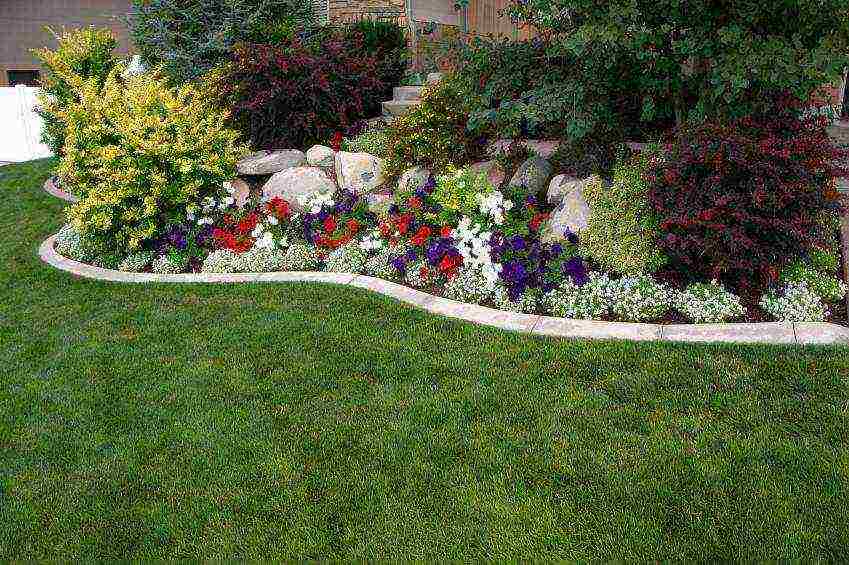
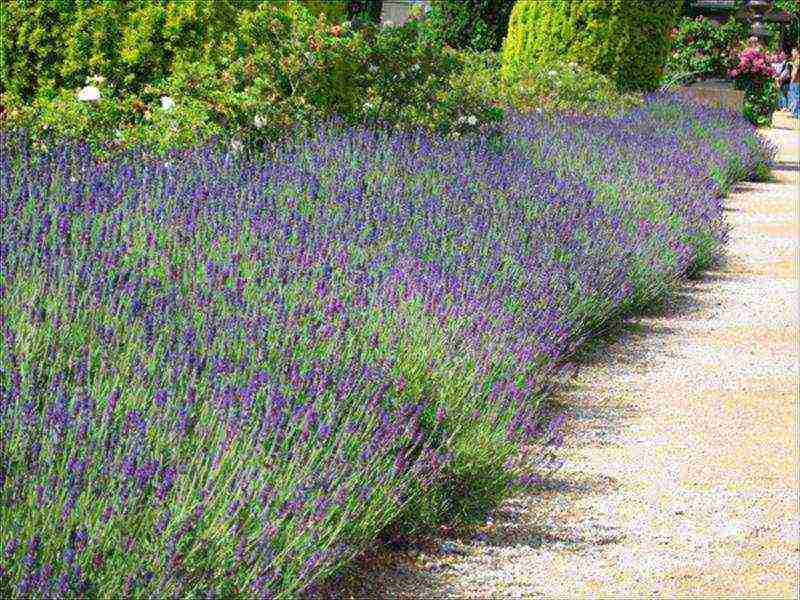
Lavender fits very well in English gardens. In this photo, she is framing a park path.

Anafalis is able to create a fairly dense coating.
Bulbous dried flowers
Bulbous dried flowers are nothing more than a lilac decorative onion.It is grown in almost all gardens from mid-May to late autumn.
Many make the mistake when, after dropping the inflorescences, it is sent to the heap for further disposal.
In most cases, summer residents use the fast-growing Aflatunsky onion, in rare cases: Christophe or Schubert.
In order to use it in a dry bouquet, it is necessary to cut it off before the time when the full disclosure of the inflorescences occurs in the onion. At the same time, it is necessary to pay attention to the fact that compositions with its combination are formed before drying, otherwise it will break off (too fragile).
In the process of growth, decorative onions can reach a diameter of about 40 centimeters, which makes an incredible impression on others.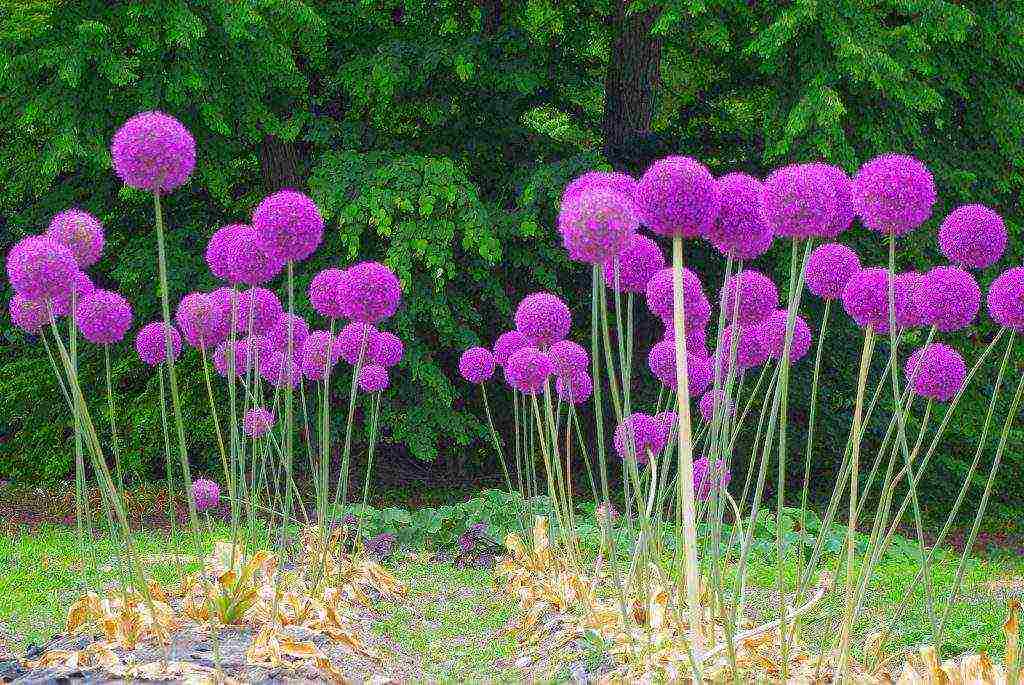
If we talk about the care itself, then it is enough to make sure that there are no extraneous grass (wild) near these plants. It is enough to remove the weed within a radius of 10-15 centimeters around the trunks.
Particular attention must be paid to watering. These plants do not like abundant watering, but also dryness. For this reason, it is recommended to water it every 3 days in summer, and in other seasons (of course not in winter) - once every 5 days.
The cultivation is very simple - small holes are made or a ditch is made and the seeds are laid out. Germination appears after 10 days.
If we talk about landscape design, then an incomparable option with a bow can be seen in the photo:
Use of ornamental cereals as dried flowers
First of all, it is necessary to pay attention to the fact that the cereals themselves have such a property as rapid fading. However, they can often be found in the formation of color compositions in various bouquets.
If we talk about the varieties of plants from this subgroup, then there are only a few of them, namely:
- Briza or, as it is popularly called, the Shaker;
- and also Haretail.
Breeze
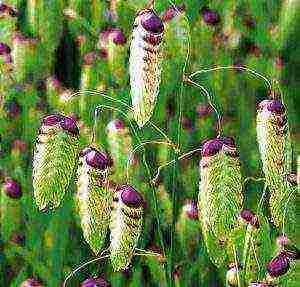
Briza (shaker)
This type of plant can often be called a pearl country. Initially, this plant has a reddish-brown inflorescence.
However, later on, the hue changes to magenta gray. For this reason, to form bouquets, this plant can be cut in several stages, thus a bouquet of different color shades is obtained from one type of flower.
Haretail
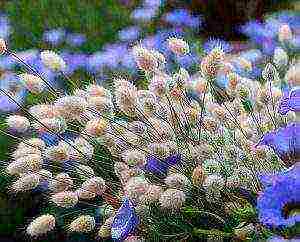
Lagurus (haretail)
Another name is lagurus. These fluffy spikelets of the plant can perfectly decorate any dry bouquet.
The key point is the fact that this type of plant, for some unknown reason, is very popular with children.
Moreover, one very interesting detail should be noted - the spikelets can be painted in any color if desired.
The cultivation of these dried flowers is very interesting. For this, small greenhouses are made in early spring. Seeds are placed in these greenhouses to a depth of no more than 1 centimeter and watered.
You can make small greenhouses, which are covered with ordinary glass on top. With the correct creation of the greenhouse (the temperature should not be less than 5 degrees Celsius), germination will already be 8-10 days.
In landscape design, these varieties of plants can complement such compositions:
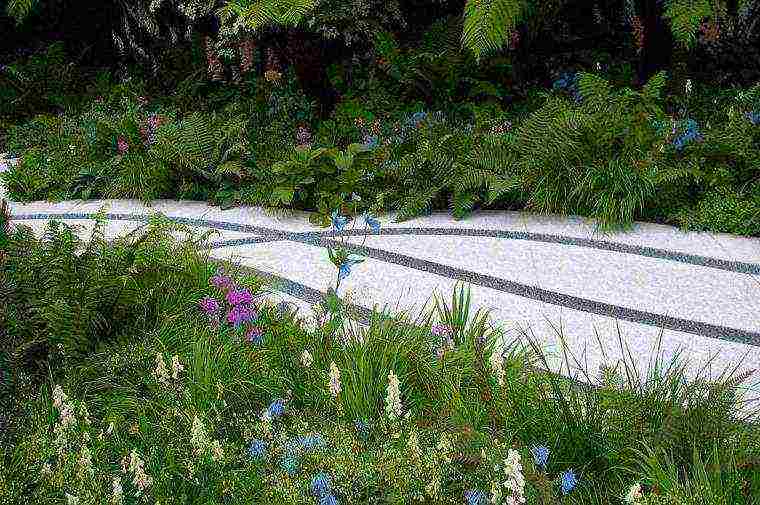
A shaker in a herb mixborder framing the walkway.
Landscape decoration with tall dried flowers
Low-growing dried-flower plants are easier to use when decorating a garden or a summer cottage: in flower beds, flower beds, to knock out a path, but bright and noticeable astilbe or bows are so expressive that a mistake will cost more. Let's consider some techniques using the example of decorative onions (Allium) and lavender.
A bright accent is a giant decorative bow. In the photo below, varieties with purple inflorescences are Allium gladiator or Allium globemaster, with lush white heads variety - Allium mount everest. It looks great with hosts, in a mixborder with other lush flowers, next to clipped green hedges. It will be a mistake to supplement it with delicate, graceful, or too small flowers - it will suppress them with its power.
Lavender is very popular. It has already been said above that it looks great along the paths. But that's not all.It goes well with roses. It is good in wild, "unkempt" compositions, but because of the exquisite lilac color it can be an excellent companion to trimmed trees, cobbled paths, garden statues and decor in a classic or even palace style. Due to the height of the plants, it can form a line separating one zone of the garden from another. There are more examples in the photo below.
Immortelle, gomfrena, rudbeckia
Gomfrena and rudbeckia are charming in the garden and in compositions. These cultures, plus the aforementioned immortelle, are described in detail in the video below.
A bright colorful summer passes, many plants fade, gradually autumn colors fill our gardens and parks. How you want to preserve the beauty of flowers and smells of summer longer, to preserve the memory of it for the long winter!
Composition of dried flowers This will help usdried flowers - plants that retain their shape, color, and sometimes aroma well for a long time. Bouquets or compositions from them will decorate the room and will remind you of summer.
The assortment of dried flowers is very large. You can see many of them in nature and collect the necessary material in the forest, in the field, by the river. Others can be grown in your garden, and in the summer they will decorate your site, and in the winter, bouquets of them will refresh your home. Today we will talk specifically about those dried flower plants that are grown in the garden.

Dried flowers in the garden.
Immortelle flowers or immortelles
This is what plants are called, the flowers of which have very hard petals. Drying, they retain their color and shape. This group includes various plants, most of them belong to the Aster family.
Gelichrizum
Gelichrizum is native to Australia and Africa, we grow in an annual culture the species Helichrizum bracts
(Helichrysum bracteatum).
Usually its large-flowered form is grown, which is called gelichrisum large (
H. monstrosum
). This is a variety with baskets up to 6 cm in diameter and many leaves of the envelope, making the flowers especially double.
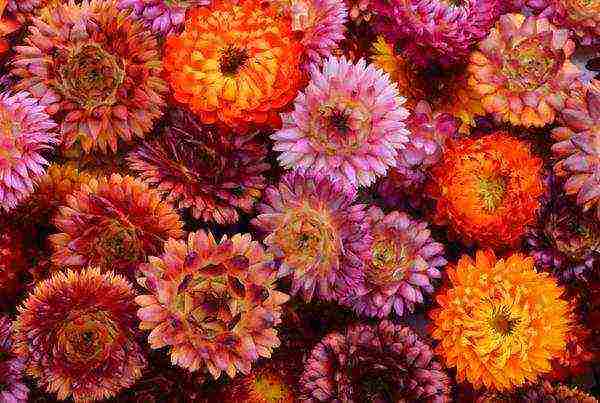
Gelichrizum flowers Plants from 40 to 100 cm tall with strong stems, forms inflorescences-baskets of various colors.
The following varieties are available: 'Fireball', 'White', 'Yellow', 'Scarlet', 'Lotos',' Spark ', one of the tallest -' King size ', grows up to 1 m. Of the undersized ones, interesting are' Leteum '(' Luteum '),' Hot Bikini '(' Hot Bikini '),' Moreska '(' Moreska '), 'Chico Red' ('Chico Red'), 'Pink Porcelain'.
Used in floriculture and other types of gelichrizum: daisy, Milford, helmet.
The most popular are pink helipterum (Helipterum roseum) or pink acroclinium (Acroclinium roseum). An annual plant native to the southwestern parts of Australia, up to 50 cm high. Forms a rosette of leaves, from which stems, occasionally branching, branch off.
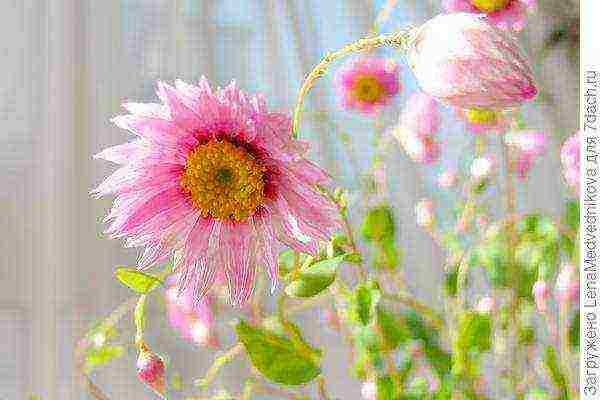
Helipterum.
It has a large-flowered shape with pink-red inflorescences. Known varieties 'Red Bonnie' ('Red Bonnie'), 'Album' ('Album'), 'Roseum' ('Roseum'), 'Yellow stars', 'Bright suns', and color mixtures, including a mixture 'Bonnie' ('Bonnie').
Winged ammobium (
Ammobium alatum
) is originally from Australia. In our climate, this is an annual plant up to 60 cm high, highly branched. Small inflorescences-baskets up to 1.5 cm with a yellow center and white dry petals (in fact, these are wrapper leaves) are very decorative.
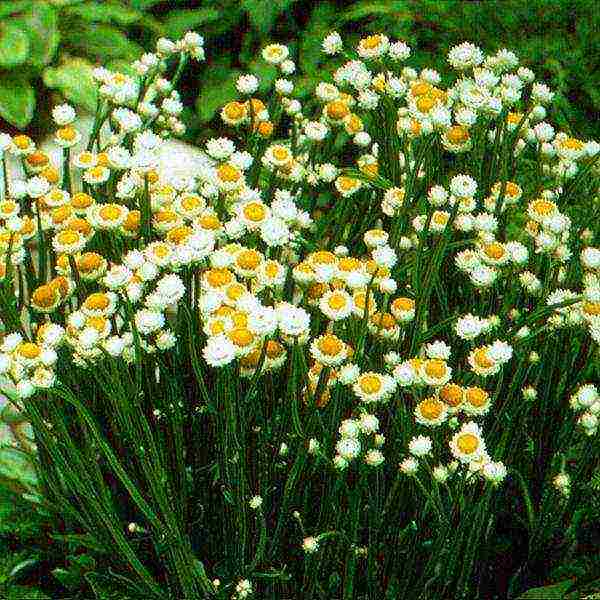
Ammobium.
Xerantemum annual (
Xeranthemum annuum
) grows in the Mediterranean and southern Russia. Strongly branched annuals up to 60 cm high. Baskets of white-pink-lilac shades 3.5-4 cm in diameter. Blooms from mid-summer to autumn. There are double and semi-double forms and varieties: ‘Rose’, ‘Violetpurpur’, ‘Carmine’, ‘Kazachok’ (mixture).

Xerantemum
Anafalis
Most common in the middle lane
anaphalis pearl
(Anaphalis margaritacea)
... This is a perennial plant, stems up to 45 cm high and narrow leaves are covered with pubescence, which makes the whole plant appear silvery. Small baskets (up to 0.8 cm) of white-silvery flowers are collected in inflorescences-shields.The plant is frost-resistant, capable of creeping very quickly.
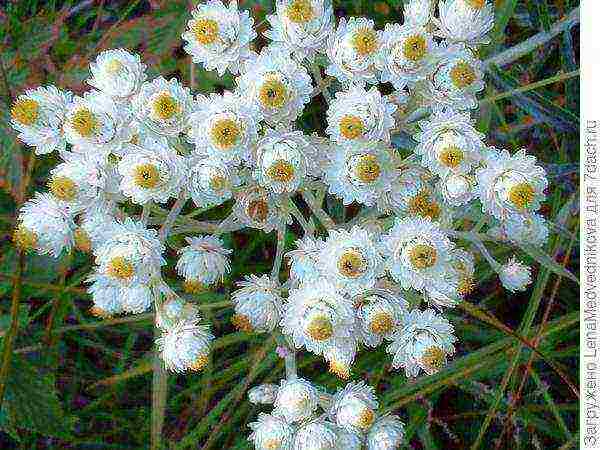
Anafalis.
In culture, gomphrene spherical is most often used
(Gomphrena globosa)
- a plant from the amaranth family. Comes from the tropical regions of America, we grow it as an annual. The plant is formed by highly branched shoots up to 35 cm tall. Small flowers, painted in white and pink-purple colors, are collected in a round or oval inflorescence 3-4 cm in diameter.

Gomfrena Available in 'High', 'Strawberry', 'Pompon', 'Bright Border', 'Pixie Mix', Gnome Series, 'Buddy White' Buddy White '),' Buddy Purple '(' Buddy Purple ').
Two types are suitable for use in dry bouquets
yarrow
.
- Yarrow meadowsweet (Achillea filipendulina). Large perennial up to 1.2 m tall. He is very dressed up thanks to the dense and flat inflorescences-shields of golden color. Blooms in July-August.

Hybrid Yarrow
- Yarrow ptarmica (Achillea ptarmica) is better known among flower growers under the name pearl mussel. It is a perennial with a creeping rhizome and shoots up to 80 cm tall. Snow-white baskets 1.5 cm in diameter are collected in loose shields. Flowering begins in July and lasts 30-35 days.
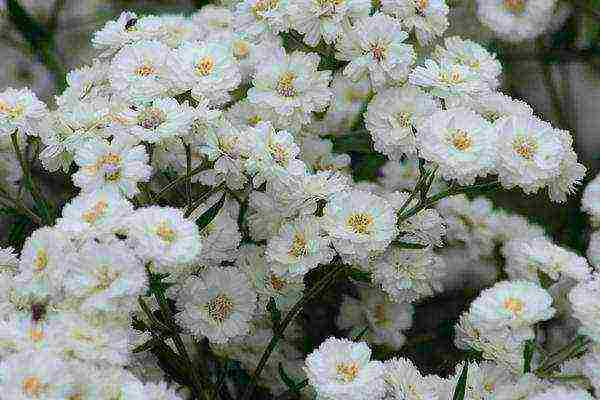
Yarrow ptarmica
Pearl oyster is added to dry bouquets to create openwork and set off other flowers with its white flowers.
There are other dried flowers, which are also called lace, they give the compositions lightness and airiness. Gypsophila is in the first place here.
In floristry, the most common gypsophila paniculata
(Gypsophila paniculata)
or
swing
... This is a perennial plant that forms lush openwork bushes in the form of a ball up to 100 cm in diameter. They consist of numerous thin branchy shoots ending in tiny white flowers that bloom in July and bloom for up to 45 days. There are garden forms with double and pink flowers.

Bouquet with gypsophila A lot of varieties have been bred: 'White Cloud', 'Snow Flakes',' Carmine ',' Flamingo ',' Mirage ',' Akulina ',' Rosenschleier '(' Rosenschleier '),' Pink Star '(' Pink Star '),' Rosea '(' Rosea ') and others.
Kermek
(Limonium)
Is a genus of 300 species that are widespread in both hemispheres. Another name is statice (statice). Annual and perennial grasses with small flowers, collected in scutes or panicles. Painted in a variety of colors - from white and pink to yellow, blue, lilac.

Kermek Some species are grown in gardens, there are varieties with large and bright flowers. For example, the following are interesting: ‘Shimmer’, ‘Snow fringe’, ‘Heather garden’.
Genus amaranth
(Amaranthus)
has 90 species, of which four are used in culture: paniculate, tailed, dark and tricolor. Tall, colorful plants with inflorescences of various shapes and colors, mainly burgundy, purple, yellow and green. It is they who are well preserved in a dried form.

Amaranth You can learn more about amaranth by reading the publication Immortal Amaranth. Do not forget to look in the comments to it, there are also many interesting things.
Celosia
Celosia
- originally from India. In floriculture, two types are used:
- Crested celosia (Celosia argentea var cristata), commonly known as scallops or cockscomb inflorescences, which come in a variety of bright colors.
- Silver feathery celosia (Celosia argentea var plumosa). Inflorescences are brightly colored, paniculate in shape.

Celosia comb
Craspedia
Only one of 30 species is cultivated by flower growers - spherical craspedia
(Craspedia globosa).
This is a perennial plant native to Australia, we grow it as an annual. Straight stems 50-70 cm high in August are crowned with round yellow inflorescences 2.5-3 cm in diameter.

Composition with craspedia Grades of craspedia: 'Cold Ball,' Drumsticks'.
The most popular among florists is the common mordovnik
(Echinops ritro) -
perennial tall (up to 1 m) plant with very strong stems and slightly thorny feathery leaves. Forms spherical blue inflorescences up to 5 cm in diameter. Flowering lasts more than a month in mid-summer.
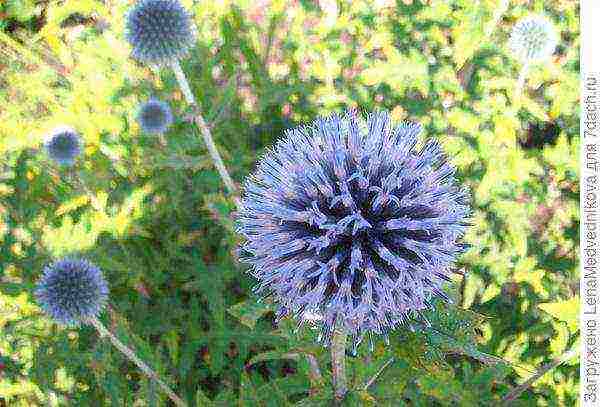
Mordovnik. Photo by the author
Varieties: ‘Blue Glow’, ‘Taplow Blue’, ‘Veitch’s Blue’.
Feverweed
Erythematosus
- tall, showy plants with gray-blue carved leaves and blue capitate inflorescences surrounded by thorny "collars". The most interesting for floriculture and use in winter bouquets are flat-leaved erythematosus
(Еryngium planum
) and alpine erythematosus
(Еryngium alpinum).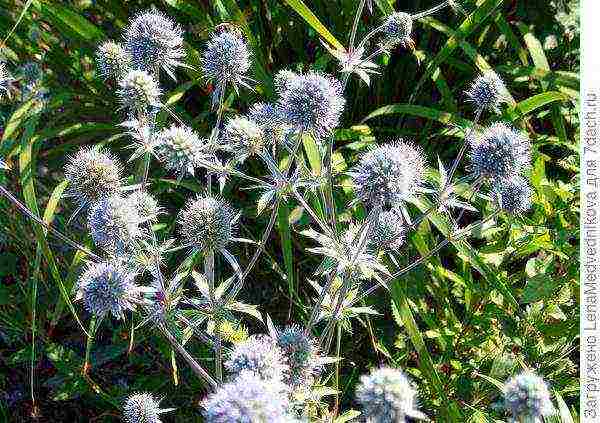
Feverweed. Photo by author Sort: ‘Amethyst’, ‘Blue Star’, ‘Blue Jackpot’, ‘Superbum’, ‘Slieve Donard’. You can read more about blueheads in the publication Meet: blueheads.
A variety of decorative bows with inflorescences-balls of blue, lilac, purple and other tones are very effective and decorative. Inflorescences of many
cereals
can also become a decoration for a winter bouquet - these are panicles of reed grass, miscanthus, reed, maned barley; spikelets of pinnacle, lagurus (haretail), foxtail, breezes and many others.

Miscanthus
Plants with interesting fruits
A bright representative -
moonwalker
annual or lunaria
(Lunaria annua).
Plant up to 60 cm tall, grown as a biennial. Florists are interested in fruits - rounded pods up to 3 cm in diameter with a transparent partition. Ripen in early autumn of the second year.

Lunar in a bouquet Some plants form fruit-boxes, they are also interesting as dried flowers. For example, the bright orange lanterns of physalis, nigella form round greenish boxes with stripes up to 3-4 cm in diameter.
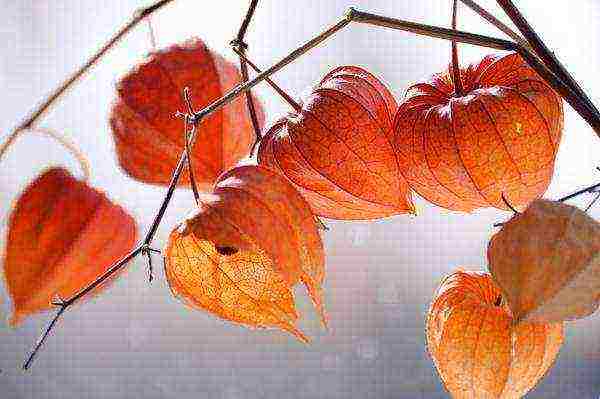
Physalis capsules Dry brown oblong capsules remain on Siberian irises after flowering. Echinacea in place of the baskets forms convex spiny balls consisting of achenes.
These are the plants that can be grown in the garden and used to create winter bouquets. This is a very exciting creative activity. On our channel you can watch a video on how to create a wonderful composition.
What dried flowers grow in your garden? Do you make floristic compositions from dried flowers? Share with us in the comments.

